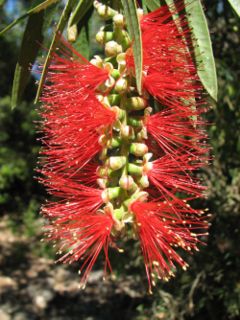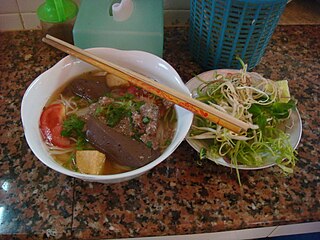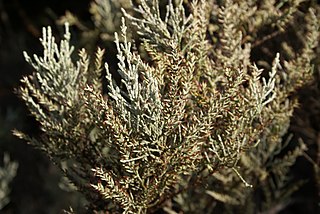
The Lamiaceae or Labiatae are a family of flowering plants commonly known as the mint or deadnettle or sage family. Many of the plants are aromatic in all parts and include widely used culinary herbs like basil, mentha, rosemary, sage, savory, marjoram, oregano, hyssop, thyme, lavender, and perilla, as well as other medicinal herbs such as catnip, salvia, bee balm, wild dagga, and oriental motherwort. Some species are shrubs, trees, or, rarely, vines. Many members of the family are widely cultivated, not only for their aromatic qualities, but also their ease of cultivation, since they are readily propagated by stem cuttings. Besides those grown for their edible leaves, some are grown for decorative foliage. Others are grown for seed, such as Salvia hispanica (chia), or for their edible tubers, such as Plectranthus edulis, Plectranthus esculentus, Plectranthus rotundifolius, and Stachys affinis. Many are also grown ornamentally, notably coleus, Plectranthus, and many Salvia species and hybrids.

Buxus is a genus of about 70 species in the family Buxaceae. Common names include box or boxwood.

Consolida is a genus of about 40 species of annual flowering plants in the family Ranunculaceae, native to western Europe, the Mediterranean and Asia. Phylogenetic studies show that Consolida is actually an annual clade nested within the genus Delphinium and it has been treated as a synonym of Delphinium in Kew's Plants of the World Online.

Callistemon is a genus of shrubs in the family Myrtaceae, first described as a genus in 1814. The entire genus is endemic to Australia but widely cultivated in many other regions and naturalised in scattered locations. Their status as a separate taxon is in doubt, some authorities accepting that the difference between callistemons and melaleucas is not sufficient for them to be grouped in a separate genus.

Viola canadensis is more commonly known as Canadian white violet, Canada violet, tall white violet, or white violet. It is widespread across much of Canada and the United States, from Alaska to Newfoundland, south as far as Georgia and Arizona.

Elsholtzia ciliata, commonly known as Vietnamese balm, xiang ru (香薷) or kinh giới in Vietnamese, is a plant native to Asia. In the US it can go by the name Crested Late Summer Mint. In US Vietnamese grocery stores is called Kinh Gioi, Vietnamese Lemon Balm or Vietnamese Lemon Mint.

Serratula is a genus of plants in the thistle tribe within the daisy family native to Eurasia. Plumeless saw-wort is a common name for plants in this genus. Serratula as traditionally defined contains at least two groups: one of which is basal within the subtribe Centaureinae and one of which is derived; the former group can be moved to the genus Klasea.
Aglaia rugulosa is a species of flowering plant in the family Meliaceae. It is found in Indonesia and Malaysia.

Polylepis rugulosa, the queñua, is a species of plant in the family Rosaceae. It is primarily found in the Andes region of South America in Argentina, Bolivia, Chile and Peru. It is currently threatened by habitat loss.

Bún riêu is a traditional Vietnamese soup of clear stock and rice vermicelli. There are several varieties of bún riêu, including bún riêu cua, bún riêu cá (fish) and bún riêu ốc (snail). This dish is well-known in the country and in the world.

Collinsonia is a genus of flowering plants in the family Lamiaceae. It is native to East Asia and eastern North America. It was named for the English botanist Peter Collinson (1694–1768) by Carl Linnaeus in Species Plantarum in 1753. It is in the tribe Elsholtzieae, a small tribe of only 5 genera. In order of their number of species, they are Elsholtzia, Mosla, Collinsonia, Perilla, and Perillula.

Doellingeria is a genus of flowering plants in the aster family. It contains species formerly included in Aster but now considered to be a distinct genus. They are known commonly as tall flat-topped asters or whitetops.

Stoebe is a genus of African plants in the pussy's-toes tribe within the daisy family.

Athanasia is a genus of flowering plants in the daisy family.

Elsholtzia is a plant genus in the Lamiaceae. It is widespread across much of temperate and tropical Asia from Siberia south to China, Northeastern India, Indonesia, etc. The genus was named in honour of the Prussian naturalist Johann Sigismund Elsholtz.
- Elsholtzia amurensisProb. - Amur region of Russia
- Elsholtzia angustifolia(Loes.) Kitag. - Korea, Manchuria
- Elsholtzia argyiH.Lév. - southern China, Vietnam
- Elsholtzia beddomeiC.B.Clarke ex Hook.f. - Myanmar, Thailand
- Elsholtzia blanda(Benth.) Benth. - southern China, Himalayas, Indochina, Sumatra, Viet Nam
- Elsholtzia bodinieriVaniot - Guizhou, Yunnan
- Elsholtzia byeonsanensisM.Kim - South Korea
- Elsholtzia capituligeraC.Y.Wu - Tibet, Sichuan, Yunnan
- Elsholtzia cephalanthaHand.-Mazz. - Sichuan
- Elsholtzia ciliata(Thunb.) Hyl. - widespread across Siberia, Russian Far East, China, India, Himalayas, Japan, Korea, Indochina
- Elsholtzia communis(Collett & Hemsl.) Diels - Myanmar, Thailand, Vietnam
- Elsholtzia concinnaVautier - Nepal, Sikkim, Bhutan
- Elsholtzia cyprianii(Pavol.) C.Y.Wu & S.Chow - central + southern China
- Elsholtzia densaBenth. - India, Pakistan, Nepal, Bhutan, Afghanistan, Kyrgyzstan, Tajikistan, Tibet, Xingjiang, China, Mongolia
- Elsholtzia eriocalyxC.Y.Wu & S.C.Huang - southern China
- Elsholtzia eriostachya(Benth.) Benth. - China, Tibet, Himalayas
- Elsholtzia feddeiH.Lév - China, Tibet
- Elsholtzia flavaBenth. - China, Himalayas
- Elsholtzia fruticosa(D.Don) Rehder - China, Himalayas, Tibet, Myanmar
- Elsholtzia glabraC.Y.Wu & S.C.Huang - China
- Elsholtzia griffithiiHook.f - Myanmar, Assam
- Elsholtzia hallasanensisY.N.Lee - Jeju-do Island in Korea
- Elsholtzia heterophyllaDiels - Yunnan, Myanmar
- Elsholtzia hunanensisHand.-Mazz. - southern China
- Elsholtzia kachinensisPrain - southern China, Myanmar, Thailand
- Elsholtzia litangensisC.X.Pu & W.Y.Chen - Sichuan
- Elsholtzia luteolaDiels - Sichuan, Yunnan
- Elsholtzia minimaNakai - Jeju-do Island in Korea
- Elsholtzia myosurusDunn - Sichuan, Yunnan
- Elsholtzia nipponicaOhwi - Japan
- Elsholtzia ochroleucaDunn - Sichuan, Yunnan
- Elsholtzia oldhamiiHemsl. - Taiwan
- Elsholtzia pendulifloraW.W.Sm - Yunnan, Thailand, Vietnam
- Elsholtzia pilosa(Benth.) Benth. - China, Himalayas, Myanmar, Vietnam
- Elsholtzia pubescensBenth. - Java, Bali, Lombok, Timor, Sulawesi
- Elsholtzia pygmaeaW.W.Sm. - Yunnan
- Elsholtzia rugulosaHemsl - southern China, Myanmar, Thailand
- Elsholtzia serotinaKom - northern China, Japan, Korea, Primorye
- Elsholtzia soulieiH.Lév. - Sichuan, Yunnan
- Elsholtzia splendensNakai ex F.Maek. - China, Korea
- Elsholtzia stachyodes(Link) Raizada & H.O.Saxena - Indian Subcontinent, China, Myanmar
- Elsholtzia stauntoniiBenth. - northern China
- Elsholtzia strobilifera(Benth.) Benth. - China, Himalayas, Myanmar
- Elsholtzia winitianaCraib - Yunnan, Guangxi, Laos, Thailand, Vietnam
Russula rugulosa is a species of agaric fungus in the family Russulaceae. It was first described by American mycologist Charles Horton Peck in 1902.

Melaleuca rugulosa, commonly known as scarlet bottlebrush, is a plant in the myrtle family, Myrtaceae and is endemic to South Australia and Victoria in Australia. It is a shrub with an open straggly habit, stiff, sharply pointed leaves and bright red bottlebrush flowers tipped with yellow in summer.
Gluta rugulosa is a tree of Borneo in the cashew and sumac family Anacardiaceae. The specific epithet rugulosa is from the Latin meaning "wrinkled", referring to the fruits.

Perilla is a genus consisting of one major Asiatic crop species Perilla frutescens and a few wild species in nature belonging to the mint family, Lamiaceae. The genus encompasses several distinct varieties of Asian herb, seed, and vegetable crop, including P. frutescens (deulkkae) and P. frutescens var. crispa (shiso). The genus name Perilla is also a frequently employed common name ("perilla"), applicable to all varieties. Perilla varieties are cross-fertile and intra-specific hybridization occurs naturally. Some varieties are considered invasive.















